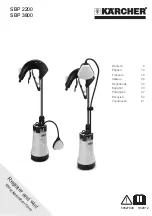
PULSAR
®
III-P/III-PE and VI-P/VI-PE PRESSURE CABINETS
Page 14
© 2019 CLEMCO INDUSTRIES CORP.
www.clemcoindustries.com
Manual No. 21527, Rev. I, 02/19
4.8.5
Unload parts, shut off the air-supply valve, drain
the air filter and pulse reservoir, and switch off the lights
and exhauster.
4.9
Pulsing (cleaning) Dust-Collector Cartridge
4.9.1
The dust-collector filter cartridge is pulsed each
time the foot pedal is pressed and again when it is
released. Prolonged periods of blasting or dusty
conditions may require the cartridge to be pulsed during
the blasting process, per Section 6.2.6, or upgrade to
the automatic pulse kit. Refer to
Section 9.1
:
Optional
Accessories
.
4.10
Shutdown
4.10.1
Shut off the air-supply valve, bleed the air-
supply line, and drain the compressed-air filter and dust-
collector pulse reservoirs.
4.10.2
Switch OFF the lights and exhauster.
5.0
ADJUSTMENTS
5.1
Blasting Pressure (pilot regulator) – Figure 15
5.1.1
The blast-pressure pilot regulator, located on the
top-left side of the cabinet, enables the user to adjust
blasting pressure to suit the application. The suitable
pressure for most purposes is about 80 psi. Lower
pressures may be used for delicate work. Higher
pressure may be required for difficult blasting jobs on
durable substrates, but it will increase media break down.
Optimal production can be achieved only when pressure
is carefully monitored.
Figure 15
5.1.2
When blasting below 40 psi, first pressurize the
blast machine at 40 psi and then turn the pressure to the
required setting before blasting the part. If the initial
pressure is below 40 psi, the pop-up valve may not seal.
5.1.3
Pressure registers on the gauge only while
blasting. While holding the nozzle securely, adjust air
pressure at the pilot regulator located on the top-left side
of the cabinet.
5.1.4
To adjust pressure, unlock the knob by pulling it
out, as shown in Figure 15, and turn it clockwise to
increase pressure or counterclockwise to decrease
pressure. Once operating pressure is set, push the knob
in to lock it and maintain the setting.
5.2
Media Metering (media flow) – Figure 16
These instructions are for a standard cabinet with
Sentinel Metering Valve. Optional metering valves
may function differently, but the process is similar.
5.2.1
Adjust media flow using the metering valve
located at the bottom of the blast machine. The valve is
closed when the handle is fully to the right. To adjust,
begin with the valve closed, press the foot pedal, and
have someone slowly move the handle to the left to
increase media flow. Allow time for the flow to stabilize
before further adjusting. The valve is fully open when the
handle is at the full-left position. The optimum flow rate
depends on the type and size of media and blasting
pressure, and can best be determined by experience.
Use as little media as possible to do the job while
maintaining the best cleaning rate. Generally, with the
correct mixture, media can be seen as light discoloration
as it exits the nozzle.
OPEN
CLOSE
Figure 16
Control Handle
Some items are
removed for clarity.
When viewed from the knob end,
turn clockwise to increase pressure;
turn counterclockwise to decrease pressure.
Adjustment Knob
Move handle to
the left to increase
media flow.
Move handle to the
right to decrease
media flow.
Blast-Pressure Pilot Regulator
Located on top-left-side of cabinet.
Push knob in to lock it.
Pull knob out to unlock
and adjust pressure.
















































